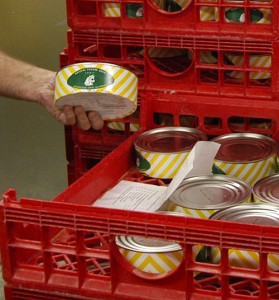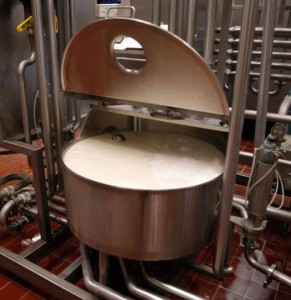
Photo Robert Hubner
WSU 19 – The secret to Cougar Gold
By Hope Belli Tinney | Posted on August 30, 2010
Categories: Food Science and Human Nutrition
We could tell you what’s in WSU 19, but then we’d have to shoot you.

Photo Robert Hubner
WSU 19 is the adjunct culture added to Cougar Gold cheese that gives it its more-than-cheddar taste. It was developed by N.S. Golding (hence Cougar Gold) at WSU in the early 1940s and has been used ever since.
“WSU 19 is our secret ingredient,” says Russ Salvadalena, manager of the WSU Creamery. “We are willing to share all of our other experiences and ingredients, but we don’t share WSU 19.”
On a recent Tuesday morning he took me through two chlorine foot baths, past the ice cream flavor vats and into the culture room where WSU 19 is stored and incubated.
“We keep this pretty much under lock and key when no one is around,” he says, removing a small plastic bottle from inside a “refrigerator” set to an internal temperature of 100 degrees.
Every day or two, for the past nearly 70 years a WSU student has transferred a portion of WSU 19 to a new nutrient bath in preparation for a new batch of cheese. The process is similar to how bakers will sometimes use the same sourdough starter for generations, Salvadalena said.
The subject of WSU 19 surfaced recently because Salvadalena got a call from a couple, Al and Susie Howell, who had a can of unopened Cougar Gold dated Oct. 1987. Their daughter, Teresa Howell Hoffman ’80, had given it to them and they’d never gotten around to opening it. When they finally opened it earlier this month at the creamery, it tasted great.
And for that, we can thank WSU 19.
Cougar Gold is created with two cultures, a lactic starter and WSU 19. Some cheddars leave a bitter aftertaste, but not Cougar Gold, not even after two decades or more in a tin can.

Photo Robert Hubner
Golding, a professor of dairy husbandry, began working on the problem of how to can cheese in the 1930s. At that time, the problem was a buildup of carbon dioxide over time, causing the cans to explode. When WWII started, the government got interested in food packaging as well, and, along with the American Can Company, gave Golding a grant to further his research.
Golding asked cheese-making colleagues from around the world to send him their bacteria cultures, Salvadalena said, and ended up making a “bacteria cocktail” that did indeed limit the production of carbon dioxide in the can. He named it WSU 19.
John Haugen, assistant creamery manager, says WSU 19 is no longer necessary to prevent explosions. The lactic starter WSU uses now will create a cheese that can ripen in a can. But, without WSU 19, it would be just another cheddar.
And for that, we can thank Dr. Golding.
LINKS
“Alumnus has stash of aged Cougar Gold” (WSU Today, Sept. 13, 2007)
“How Cougar Gold Made the World a Better Place” (Washington State Magazine, Winter 2004)
“Oldest Cougar Gold cracked opened, still tasty” (WSU Today, Aug. 14, 2010)
Gallery: The cheesemaking process at WSU (Washington State Magazine)
 The Discovery blog was a magazine commentary that ran from 2009 to 2012 chronicling the creative and intellectual excitement of discovery found in the many investigations and discussion at Washington State University. The site was unfortunately depreciated and is no longer maintained.
The Discovery blog was a magazine commentary that ran from 2009 to 2012 chronicling the creative and intellectual excitement of discovery found in the many investigations and discussion at Washington State University. The site was unfortunately depreciated and is no longer maintained.